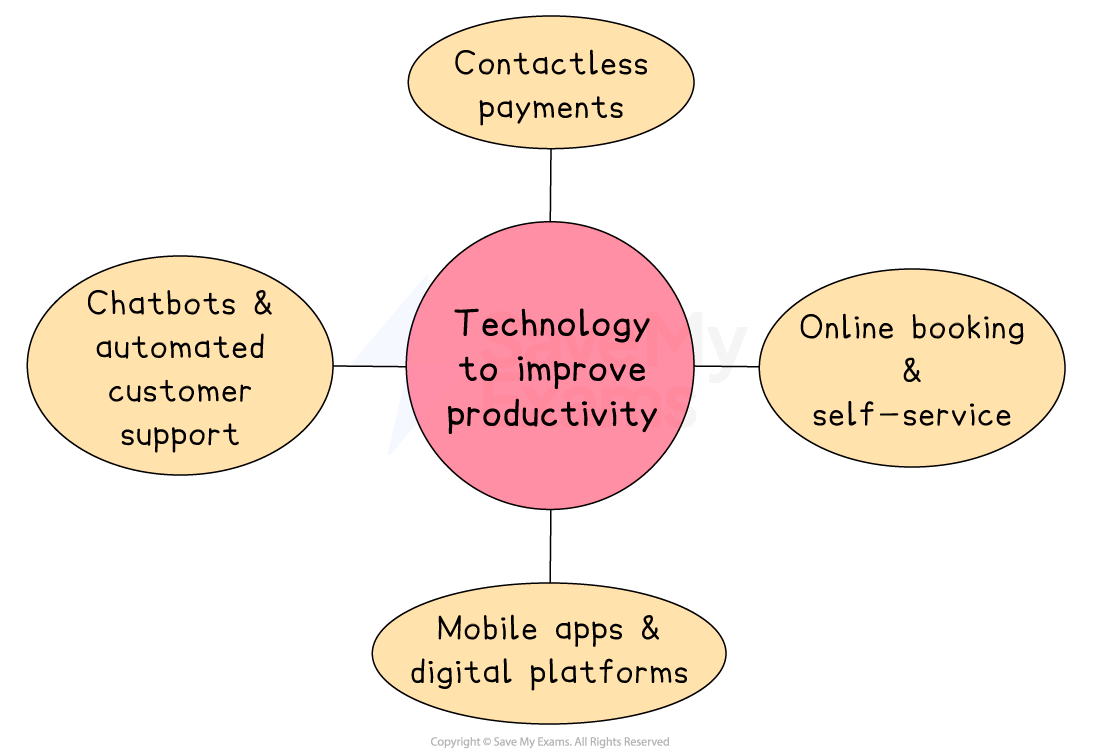Syllabus Edition
First teaching 2025
First exams 2027
Changing Technology & Productivity (Cambridge (CIE) IGCSE Business): Revision Note
Exam code: 0450, 0986 & 0264, 0774
Technology is improving the service sector
Technology is helping service-based businesses work more efficiently, serve customers faster, and reduce operating costs

Technology to improve productivity
Contactless payments
Contactless payment systems allow customers to pay quickly by tapping a card, phone or smartwatch on a payment terminal
This speeds up the transaction process and reduces waiting times in shops, cafés and other service businesses
Online booking and self-service
Many service businesses now allow customers to book appointments, check-in or place orders online without needing help from staff
Self-service kiosks and websites reduce pressure on frontline workers
Fewer staff are needed at reception or check-in desks, and customers can be processed quickly and accurately
For example, Formule 1 hotels offer online check-in and key collection kiosks, allowing guests to go straight to their rooms without waiting at reception
Chatbots and automated customer support
Chatbots are software programs that can answer customer queries automatically through websites, apps or messaging services
They are available 24/7 and can handle common requests like opening hours, order updates or booking changes
Staff are freed up to deal with more complex issues, while routine queries are handled automatically, reducing workload
Mobile apps and digital platforms
Mobile apps allow customers to access services quickly and give businesses real-time information about demand, location and performance
Apps are widely used in transport, food delivery and entertainment services
Businesses can manage orders, staff and customers more efficiently using real-time data, improving speed and reducing delays
For example, Deliveroo uses its app to connect customers with nearby restaurants and delivery riders, ensuring fast service and better route planning
The impact of changes in technology
Technology brings many benefits to businesses and employees, but it also creates challenges, especially in the way people work and the skills they need
Impact on the business
Advantages | Disadvantages |
|---|---|
|
|
Impact on employees
Advantages | Disadvantages |
|---|---|
|
|
How changes in technology improves business performance
Technology directly affects how well a business performs by improving processes, reducing costs and helping the business meet customer needs more effectively
Profitability
Technology helps businesses increase profits by lowering production and operating costs
Automation reduces the need for large numbers of employees, and digital systems can reduce waste and errors
Lower costs and higher output can lead to higher profit margins and better overall financial performance over time
Efficiency and productivity
Digital tools and machines allow businesses to produce more in less time and with fewer mistakes
Technology can also help manage tasks such as inventory control, scheduling and communication
Improved efficiency leads to quicker delivery times, lower labour costs and higher overall output, all of which help improve business performance
Customer satisfaction
Technology can improve the customer experience by making it easier, faster, and more convenient to buy and use products or services
It also allows businesses to respond to customers more effectively
Higher customer satisfaction can lead to repeat purchases, positive reviews and stronger customer loyalty, helping the business grow
Quality
Technology increases quality by reducing human error and allowing businesses to follow exact specifications
Quality control systems can detect problems early in the production process.
Better quality leads to fewer returns or complaints, which protects the business’s reputation and saves money
Innovation and competitiveness
Technology enables businesses to develop new ideas more easily and respond quickly to market change
Digital tools help businesses research trends, test products and improve designs.
Innovation helps businesses stay competitive, attract new customers and enter new markets
Examiner Tips and Tricks
In evaluation questions, show balance by noting both gains (like efficiency and output) and possible downsides (such as training costs or redundancies).

Unlock more, it's free!
Did this page help you?